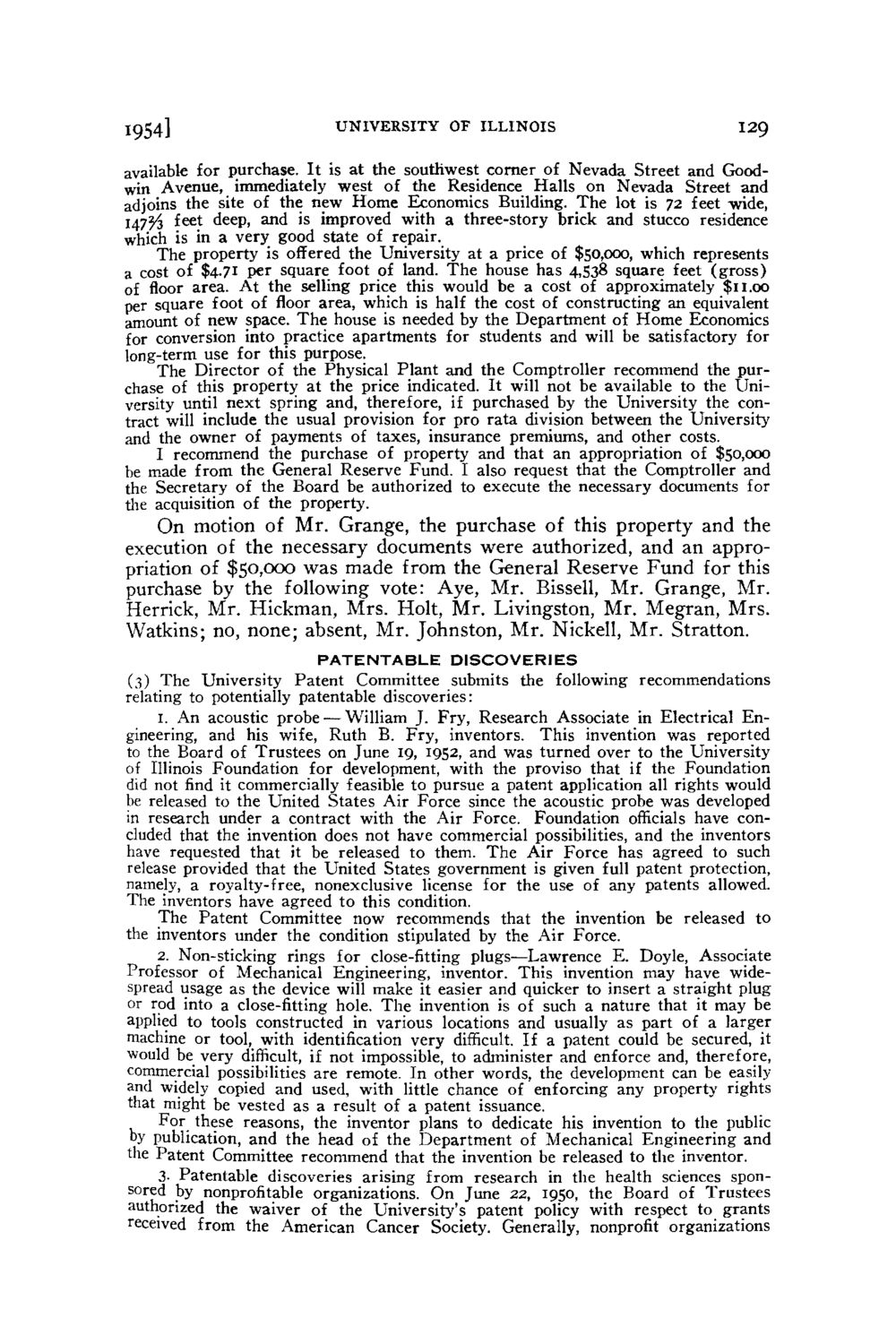| |
| |
Caption: Board of Trustees Minutes - 1956
This is a reduced-resolution page image for fast online browsing.

EXTRACTED TEXT FROM PAGE:
1954] UNIVERSITY OF ILLINOIS 129 available for purchase. It is at the southwest corner of Nevada Street and Goodwin Avenue, immediately west of the Residence Halls on Nevada Street and adjoins the site of the new Home Economics Building. The lot is 72 feet -wide, 147J3 feet deep, and is improved with a three-story brick and stucco residence which is in a very good state of repair. The property is offered the University at a price of $50,000, which represents a cost of $4.71 per square foot of land. The house has 4,538 square feet (gross) of floor area. At the selling price this would be a cost of approximately $11.00 per square foot of floor area, which is half the cost of constructing an equivalent amount of new space. The house is needed by the Department of Home Economics for conversion into practice apartments for students and will be satisfactory for long-term use for this purpose. The Director of the Physical Plant and the Comptroller recommend the purchase of this property at the price indicated. It will not be available to the University until next spring and, therefore, if purchased by the University the contract will include the usual provision for pro rata division between the University and the owner of payments of taxes, insurance premiums, and other costs. I recommend the purchase of property and that an appropriation of $50,000 be made from the General Reserve Fund. I also request that the Comptroller and the Secretary of the Board be authorized to execute the necessary documents for the acquisition of the property. On motion of Mr. Grange, the purchase of this property and the execution of the necessary documents were authorized, and an appropriation of $50,000 was made from the General Reserve Fund for this purchase by the following vote: Aye, Mr. Bissell, Mr. Grange, Mr. Herrick, Mr. Hickman, Mrs. Holt, Mr. Livingston, Mr. Megran, Mrs. Watkins; no, none; absent, Mr. Johnston, Mr. Nickell, Mr. Stratton. PATENTABLE DISCOVERIES (3) The University Patent Committee submits the following recommendations relating to potentially patentable discoveries: 1. An acoustic probe-—William J. Fry, Research Associate in Electrical Engineering, and his wife, Ruth B. Fry, inventors. This invention was reported to the Board of Trustees on June 19, 1952, and was turned over to the University of Illinois Foundation for development, with the proviso that if the Foundation did not find it commercially feasible to pursue a patent application all rights would be released to the United States Air Force since the acoustic probe was developed in research under a contract with the Air Force. Foundation officials have concluded that the invention does not have commercial possibilities, and the inventors have requested that it be released to them. The Air Force has agreed to such release provided that the United States government is given full patent protection, namely, a royalty-free, nonexclusive license for the use of any patents allowed. The inventors have agreed to this condition. The Patent Committee now recommends that the invention be released to the inventors under the condition stipulated by the Air Force. 2. Non-sticking rings for close-fitting plugs—Lawrence E. Doyle, Associate Professor of Mechanical Engineering, inventor. This invention may have widespread usage as the device will make it easier and quicker to insert a straight plug or rod into a close-fitting hole. The invention is of such a nature that it may be applied to tools constructed in various locations and usually as part of a larger machine or tool, with identification very difficult. If a patent could be secured, it would be very difficult, if not impossible, to administer and enforce and, therefore, commercial possibilities are remote. In other words, the development can be easily and widely copied and used, with little chance of enforcing any property rights that might be vested as a result of a patent issuance. For these reasons, the inventor plans to dedicate his invention to the public by publication, and the head of the Department of Mechanical Engineering and the Patent Committee recommend that the invention be released to the inventor. 3- Patentable discoveries arising from research in the health sciences sponsored by nonprofitable organizations. On June 22, 1950, the Board of Trustees authorized the waiver of the University's patent policy with respect to grants received from the American Cancer Society. Generally, nonprofit organizations
| |